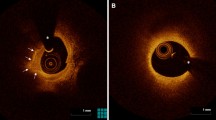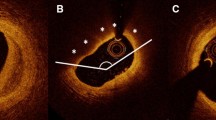Abstract
Background
Layered plaque is a signature of previous subclinical plaque destabilization and healing. Following plaque disruption, thrombus becomes organized, resulting in creation of a new layer, which might contribute to rapid step-wise progression of the plaque. However, the relationship between layered plaque and plaque volume has not been fully elucidated.
Methods
Patients who presented with acute coronary syndromes (ACS) and underwent pre-intervention optical coherence tomography (OCT) and intravascular ultrasound (IVUS) imaging of the culprit lesion were included. Layered plaque was identified by OCT, and plaque volume around the culprit lesion was measured by IVUS.
Results
Among 150 patients (52 with layered plaque; 98 non-layered plaque), total atheroma volume (183.3 mm3[114.2 mm3 to 275.0 mm3] vs. 119.3 mm3[68.9 mm3 to 185.5 mm3], p = 0.004), percent atheroma volume (PAV) (60.1%[54.7–60.1%] vs. 53.7%[46.8–60.6%], p = 0.001), and plaque burden (86.5%[81.7–85.7%] vs. 82.6%[77.9–85.4%], p = 0.001) were significantly greater in patients with layered plaques than in those with non-layered plaques. When layered plaques were divided into multi-layered or single-layered plaques, PAV was significantly greater in patients with multi-layered plaques than in those with single-layered plaques (62.1%[56.8–67.8%] vs. 57.5%[48.9–60.1%], p = 0.017). Layered plaques, compared to those with non-layered pattern, had larger lipid index (1958.0[420.9 to 2502.9] vs. 597.2[169.1 to 1624.7], p = 0.014).
Conclusion
Layered plaques, compared to non-layered plaques, had significantly greater plaque volume and lipid index. These results indicate that plaque disruption and the subsequent healing process significantly contribute to plaque progression at the culprit lesion in patients with ACS.
Clinical Trial Registration
http://www.clinicaltrials.gov, NCT01110538, NCT03479723, UMIN000041692.


Similar content being viewed by others
References
Virmani R, Kolodgie FD, Burke AP, Farb A, Schwartz SM (2000) Lessons from sudden coronary death: a comprehensive morphological classification scheme for atherosclerotic lesions. Arterioscler Thromb Vasc Biol 20:1262–1275
Vergallo R, Crea F (2020) Atherosclerotic Plaque Healing. N Engl J Med 383:846–857
Burke AP, Kolodgie FD, Farb A, Weber DK, Malcom GT, Smialek J et al (2001) Healed plaque ruptures and sudden coronary death: evidence that subclinical rupture has a role in plaque progression. Circulation 103:934–940
Yamamoto MH, Yamashita K, Matsumura M, Fujino A, Ishida M, Ebara S et al (2017) Serial 3-Vessel Optical Coherence Tomography and Intravascular Ultrasound Analysis of changing Morphologies Associated with lesion progression in patients with stable angina Pectoris. Circ Cardiovasc Imaging. ; 10
Fracassi F, Crea F, Sugiyama T, Yamamoto E, Uemura S, Vergallo R et al (2019) Healed culprit plaques in patients with Acute Coronary Syndromes. J Am Coll Cardiol 73:2253–2263
Sugiyama T, Yamamoto E, Fracassi F, Lee H, Yonetsu T, Kakuta T et al (2019) Calcified plaques in patients with Acute Coronary Syndromes. JACC Cardiovasc Interv 12:531–540
Nakajima A, Libby P, Mitomo S, Yuki H, Araki M, Seegers LM et al (2022) Biomarkers associated with coronary high-risk plaques. J Thromb Thrombolysis.
O’Gara PT, Kushner FG, Ascheim DD, Casey DE Jr, Chung MK, de Lemos JA et al (2013) 2013 ACCF/AHA guideline for the management of ST-elevation myocardial infarction: a report of the American College of Cardiology Foundation/American Heart Association Task Force on Practice Guidelines. J Am Coll Cardiol 61:e78–e140
Amsterdam EA, Wenger NK, Brindis RG, Casey DE Jr, Ganiats TG, Holmes DR Jr et al (2014) 2014 AHA/ACC Guideline for the management of patients with Non-ST-Elevation Acute Coronary Syndromes: a report of the American College of Cardiology/American Heart Association Task Force on Practice Guidelines. J Am Coll Cardiol 64:e139–e228
Araki M, Park SJ, Dauerman HL, Uemura S, Kim JS, Di Mario C et al (2022) Optical coherence tomography in coronary atherosclerosis assessment and intervention. Nat Rev Cardiol 19:684–703
Kato K, Yonetsu T, Kim SJ, Xing L, Lee H, McNulty I et al (2012) Nonculprit plaques in patients with acute coronary syndromes have more vulnerable features compared with those with non-acute coronary syndromes: a 3-vessel optical coherence tomography study. Circ Cardiovasc Imaging 5:433–440
Vergallo R, Uemura S, Soeda T, Minami Y, Cho JM, Ong DS et al (2016) Prevalence and predictors of multiple coronary plaque ruptures: in vivo 3-Vessel Optical Coherence Tomography Imaging Study. Arterioscler Thromb Vasc Biol 36:2229–2238
Nakajima A, Araki M, Minami Y, Soeda T, Yonetsu T, McNulty I et al (2022) Layered plaque characteristics and layer burden in Acute Coronary Syndromes. Am J Cardiol 164:27–33
Mintz GS, Nissen SE, Anderson WD, Bailey SR, Erbel R, Fitzgerald PJ et al (2001) American College of Cardiology Clinical Expert Consensus Document on Standards for Acquisition, Measurement and Reporting of Intravascular Ultrasound Studies (IVUS). A report of the American College of Cardiology Task Force on Clinical Expert Consensus documents. J Am Coll Cardiol 37:1478–1492
Nissen SE, Nicholls SJ, Wolski K, Rodés-Cabau J, Cannon CP, Deanfield JE et al (2008) Effect of rimonabant on progression of atherosclerosis in patients with abdominal obesity and coronary artery disease: the STRADIVARIUS randomized controlled trial. JAMA 299:1547–1560
Nicholls SJ, Ballantyne CM, Barter PJ, Chapman MJ, Erbel RM, Libby P et al (2011) Effect of two intensive statin regimens on progression of coronary disease. N Engl J Med 365:2078–2087
Davies MJ, Bland JM, Hangartner JR, Angelini A, Thomas AC (1989) Factors influencing the presence or absence of acute coronary artery thrombi in sudden ischaemic death. Eur Heart J 10:203–208
Davies MJ (1996) Stability and instability: two faces of coronary atherosclerosis. The Paul Dudley White Lecture 1995. Circulation 94:2013–2020
Mann J, Davies MJ (1999) Mechanisms of progression in native coronary artery disease: role of healed plaque disruption. Heart 82:265–268
Russo M, Kim HO, Kurihara O, Araki M, Shinohara H, Thondapu V et al (2020) Characteristics of non-culprit plaques in acute coronary syndrome patients with layered culprit plaque. Eur Heart J Cardiovasc Imaging 21:1421–1430
Uemura S, Ishigami K, Soeda T, Okayama S, Sung JH, Nakagawa H et al (2012) Thin-cap fibroatheroma and microchannel findings in optical coherence tomography correlate with subsequent progression of coronary atheromatous plaques. Eur Heart J 33:78–85
Araki M, Yonetsu T, Kurihara O, Nakajima A, Lee H, Soeda T et al (2021) Predictors of Rapid Plaque Progression: an optical coherence Tomography Study. JACC Cardiovasc Imaging 14:1628–1638
Shiran A, Mintz GS, Leiboff B, Kent KM, Pichard AD, Satler LF et al (1999) Serial volumetric intravascular ultrasound assessment of arterial remodeling in left main coronary artery disease. Am J Cardiol 83:1427–1432
Yamada R, Okura H, Kume T, Saito K, Miyamoto Y, Imai K et al (2010) Relationship between arterial and fibrous cap remodeling: a serial three-vessel intravascular ultrasound and optical coherence tomography study. Circ Cardiovasc Interv 3:484–490
Von Birgelen C, Hartmann M, Mintz GS, Böse D, Eggebrecht H, Gössl M et al (2004) Spectrum of remodeling behavior observed with serial long-term (>/=12 months) follow-up intravascular ultrasound studies in left main coronary arteries. Am J Cardiol 93:1107–1113
Puri R, Nissen SE, Ballantyne CM, Barter PJ, Chapman MJ, Erbel R et al (2013) Factors underlying regression of coronary atheroma with potent statin therapy. Eur Heart J 34:1818–1825
Schoenhagen P, Ziada KM, Kapadia SR, Crowe TD, Nissen SE, Tuzcu EM (2000) Extent and direction of arterial remodeling in stable versus unstable coronary syndromes: an intravascular ultrasound study. Circulation 101:598–603
Puri R, Nicholls SJ, Ellis SG, Tuzcu EM, Kapadia SR (2014) High-risk coronary atheroma: the interplay between ischemia, plaque burden, and disease progression. J Am Coll Cardiol 63:1134–1140
Yokoya K, Takatsu H, Suzuki T, Hosokawa H, Ojio S, Matsubara T et al (1999) Process of progression of coronary artery lesions from mild or moderate stenosis to moderate or severe stenosis: a study based on four serial coronary arteriograms per year. Circulation 100:903–909
Xie Z, Hou J, Yu H, Jia H, Du H, Lee H et al (2016) Patterns of coronary plaque progression: phasic versus gradual. A combined optical coherence tomography and intravascular ultrasound study. Coron Artery Dis 27:658–666
Ross R (1999) Atherosclerosis–an inflammatory disease. N Engl J Med 340:115–126
Nakajima A, Sugiyama T, Araki M, Seegers LM, Dey D, McNulty I et al (2022) Plaque rupture, compared with plaque Erosion, is Associated with a higher level of Pancoronary inflammation. JACC Cardiovasc Imaging 15:828–839
Libby P (2013) Mechanisms of acute coronary syndromes and their implications for therapy. N Engl J Med 368:2004–2013
Acknowledgements
The authors thank Tsunenari Soeda (Nara Medical University), Yoshiyasu Minami (Kitasato University), Takumi Higuma (St. Marianna University), Masamichi Takano (Nippon Medical School), and Bryan P. Yan (Chinese University of Hong Kong) for their help in enrolling patients.
Funding
Dr. Jang’s research has been supported by Mrs. Gillian Gray through the Allan Gray Fellowship Fund in Cardiology and by Mukesh and Priti Chatter through the Chatter Foundation. The funder had no role in the design or conduct of this research.
Author information
Authors and Affiliations
Corresponding authors
Ethics declarations
Conflict of Interest
Dr. Jang has received educational grant support from Abbott Vascular. All other authors have no relationships relevant to the contents of this paper to disclose.
Additional information
Publisher’s Note
Springer Nature remains neutral with regard to jurisdictional claims in published maps and institutional affiliations.
Electronic supplementary material
Below is the link to the electronic supplementary material.
Rights and permissions
Springer Nature or its licensor (e.g. a society or other partner) holds exclusive rights to this article under a publishing agreement with the author(s) or other rightsholder(s); author self-archiving of the accepted manuscript version of this article is solely governed by the terms of such publishing agreement and applicable law.
About this article
Cite this article
Yuki, H., Kinoshita, D., Suzuki, K. et al. Layered plaque and plaque volume in patients with acute coronary syndromes. J Thromb Thrombolysis 55, 432–438 (2023). https://doi.org/10.1007/s11239-023-02788-9
Accepted:
Published:
Issue Date:
DOI: https://doi.org/10.1007/s11239-023-02788-9




